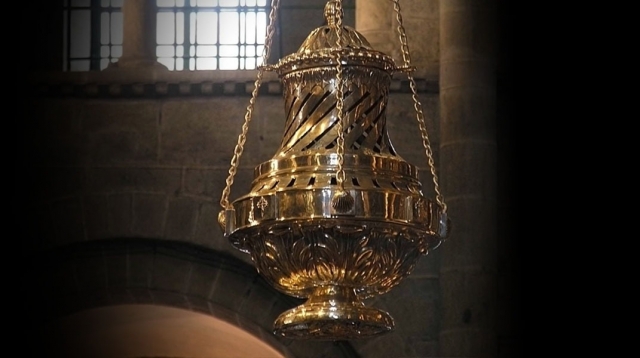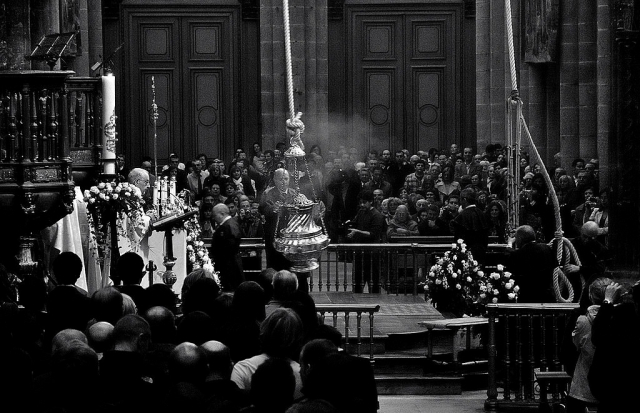All about the Botafumeiro: What is it, when does it start?
We tell you what is exactly the botafumeiro of the Cathedral of Santiago, what it is for and what days of the year you will see it on the move
What is the botafumeiro?
The botafumeiro (which means "censer" in Galician) is a large liturgical vessel that hangs from the dome of the Cathedral of Santiago and that spreads incense throughout the temple moving from one side to another thanks to a system of pulleys. The botafumeiro is operated by eight 'tiraboleiros', in charge of pushing it first and pulling the rope afterwards, in order to make the container full of incense and coal pick up speed. The tiraboleiros can move the botafumeiro so that it reaches up to 68 km / h, going up to a height of 21 meters, drawing an arch of 65 meters.
What is the use of the botafumeiro?
The function of the botafumeiro is to spread incense through the temple and in this way to perfume it to eliminate unpleasant odors. This tradition began in the eleventh century, with the rise of the Camino de Santiago, which attracted a large number of pilgrims to the cathedral just after finishing their trip, without having been able to wash or rest.
In ancient times the churches and cathedrals of the Camino sheltered the pilgrims at night, so the bad smells were concentrated in the temples, so it was necessary to use incense to scare away the stench. The size of the botafumeiro of the Cathedral of Santiago obeys to the dimensions of the temple and the fact of being the end of the Camino, which concentrated many pilgrims who concluded their pilgrimage to Santiago.
How many times did the Botafumeiro of the Cathedral of Santiago de Compostela shoot out?
Origin of the Botafumeiro
When can you see the botafumeiro in motion?
The botafumeiro of the Cathedral of Santiago "flies" in a total of 12 occasions a year, of which nine are fixed days and three are festivities that change of day according to the year. However you should know that since the 28/1/2019 and the following 12 months the interior of the cathedral is under construction for the Xacobeo Year 2021, so no liturgies are performed (and therefore the botafumeiro is not used ).
Below you will find all the dates in which you can see the botafumeiro in movement updated to the liturgical calendar of 2019. According to the Pilgrim's Welcome Office, the botafumeiro can also function on the occasion of pilgrimages that have requested it.
- January 6 (The Epiphany of the Lord)
- April 21 (Resurrection Sunday)
- May 23 (Appearance of the Apostle Santiago in the Battle of Clavijo)
- The Ascension of the Lord
- Pentecost
- July 25 (The Martyrdom of Santiago)
- August 15 (The Assumption of Mary)
- November 1 (All Saints' Day)
- Feast of Christ the King
- December 8 (The Immaculate Conception)
- December 25 (Christmas Day)
- December 30 (Ceremony of Translation of the remains of the Apostle)
Related
Routes
Blog
 How to get to Sarria to do the Camino de Santiago
How to get to Sarria to do the Camino de Santiago
 Descubre la magia del Camino de Santiago Portugués por la costa
Descubre la magia del Camino de Santiago Portugués por la costa
 5 tours culturales que puedes hacer en Galicia si decides hacer un alto en el camino
5 tours culturales que puedes hacer en Galicia si decides hacer un alto en el camino
 Doing the Camino de Santiago in June: What you should know?
Doing the Camino de Santiago in June: What you should know?
Information
Points of interest
Cities & Towns | Hostels | Lodgings | Restaurants | Saddlery | Doctors | Points of interest | Bikes workshop
Contact us | Privacy policy | Cookies policy | | Terms of use | Authorship | Web Map | Consentimiento
© Copyright LA VOZ DE GALICIA S.A. Polígono de Sabón, Arteixo, A CORUÑA (ESPAÑA) Inscrita en el Registro Mercantil de A Coruña en el Tomo 2438 del Archivo, Sección General, a los folios 91 y siguientes, hoja C-2141. CIF: A-15000649
Developed and managed byHyliacom

